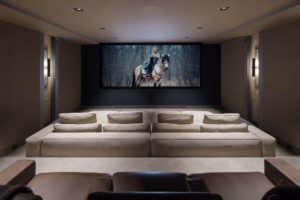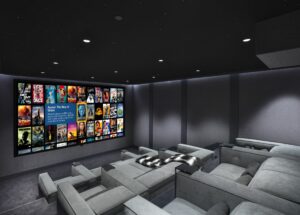Unearthing the Sonic Aromas of Rogue One: A Star Wars Story
Kaleidescape Curator Notes
Rogue One: A Star Wars Story shines as one of the best Star Wars movies, even without the franchise’s original characters and acrobatic light saber duels. Directed by Gareth Edwards, Rogue One debuted in December 2016 and stars an ensemble cast led by Felicity Jones as Jyn Erso; Diego Luna as Cassian Andor; Ben Mendelsohn as Orson Krennic; Mads Mikkelsen as Galen Erso; Alan Tudyk as K-2SO; Riz Ahmed as Bodhi Rook; Donnie Yen as Chirrut Îmwe and Jiang Wen as Baze Malbus.
Preferred Pairing: Second label wines. These are the bottles that top wineries create when they have excess juice from their harvests and want to try something new without changing their brand.
When to Consume: Second label wines are ready to consume upon opening, unlike their older siblings that are meant to age for decades. Similarly, Rogue One is a movie to watch anytime – but best served as an aperitif to a Star Wars saga binge of Episodes 4, 5, and 6. Pop a bottle (or several) and drink liberally – the rapid pace, planet-hopping and riveting action of the film could benefit from the calming effects of delicious wine.
Body of Work
Rogue One is the franchise’s grittiest film, portraying realistic battle scenes and heroes with questionable morals. Yet it avoids the pitfalls of one-note, depressing war movies through its deployment of humor and witty banter between characters. K-2SO produces many memorable, laugh-out-loud lines. Donnie Yen as Chirrut Îmwe and Jiang Wen as Baze Malbus fill out the comic relief while retaining a depth of character that stirs up more emotion than your typical movie sidekicks.
Rogue One has three main acts. In act one, we meet our main characters, establish their motivations and watch their lives intersect. Act two is moving the pieces around the galaxy, chasing McGuffins and setting the stage for the big push at the end. The final act is a frenzied hour-long battle on the ground, in the air and in space above the planet Scarif.
Rogue One was shot around the world: a black sand beach on coastal Iceland (Eadu), the Wadi Rum desert in Jordan (Jedha) and the tropical paradise of the Maldives (Scarif). Other scenes were shot in a London Tube station and in studios in England.
This was the first Star Wars movie not to be scored by John Williams. Instead, Michael Giacchino scored the film, composer of soundtracks for films such as Star Trek, Mission Impossible – Ghost Protocol, Doctor Strange and many others. Still, the music echoes themes from other Star Wars films.
“On Rogue One, I was contacted by Michael Giacchino to mix the score that he was composing. Michael’s score was perfect for this gritty Star Wars movie. The score gave emotional balance, danced around with variations of those well-known themes of John Williams original Star Wars score. No easy Task.”
Michael Semanick
The cinematography is stunning, combining gorgeous locales, realistic-looking CGI additions and impressive practical effects. The sum of these elements creates a world that feels lived-in, as opposed to the Star Wars prequels that were shot largely on green screen.
In the movie’s first act, we visit Jedha, which sits atop a plateau, once a holy city for Jedi but now under tight lock down by imperial troops. The camera pans over massive, eroding fallen statues of Jedi in the desert and a star destroyer hovers just above the city.
As we walk through the crowded streets, we are thrust into the chaos of urban warfare when a fanatical group of rebels, led by clone war veteran Saw Gerrera (Forest Whitaker), ambushes an Imperial convoy. Here, the Dolby Atmos soundtrack immerses viewers deep in the center of the action. Shots are fired around us. We turn to see where the cries of a child caught in battle are coming from. Voices of soldiers in English and alien languages surround us, and explosions come from above, below and all around.
Our time on Jedha also delivers the Death Star’s inaugural attack. Onboard the planet-killer, Grand Moff Tarkin (a digitally revived Peter Cushing, who died in 1994) decides not to destroy the planet. Instead he orders the city itself targeted, explaining with this pithy line: “We need a statement, not a manifesto.”
That “statement” results in an immense tidal wave of earth radiating hundreds of miles from the blast site. From the perspective of the rebels fleeing Saw Gerrera’s desert hideout, death seems imminent, and the deep rumbling of the bass and thudding of falling rocks and dirt surround viewers. Escape seems impossible, until a speck of a ship streams across the vanishing horizon just in time to pick up our main characters.
Unlike war-torn Jedha, Scarif is a tropical paradise. Soon, though, this lush landscape is thrown into turmoil as the rebels stage a three-pronged attack – on the ground, in the sky and in space above the planet. Tension, action and emotion collide as the rebels infiltrate and ambush the Empire base and the rebel fleet joins the battle. Sharp-eyed fans will notice familiar faces among the X-wing and Y-wing pilots attacking the planet’s protective force shield. Edwards found and seamlessly integrated decades-old clips of unused archival footage from the original 1977 Star Wars showing both Red and Gold leaders from the Death Star trench run.
One of my favorite moments in the film is during the battle on Scarif. It Is the moment after Jyn and Krennic have their show down. The music plays almost opera like and fore front, sound effects and dialog drop back. The shields are taken down, Jyn transmits the Death Star plans, The Death Star shows up. Given this triumphant moment in the film, it was a bold move to pull sound back. This plays all the way through the Death Star Blast, the death of Jyn and Cassian and until Vader shows up to unleash his wrath in which sound effects return to full power and music drops back. I believe by using this type of sonic dynamics it helped make this the most powerful sequence in Rogue One.
Michael Semanick
In yet another visually masterful scene, rebels slam a Hammerhead Corvette ship into a disabled star destroyer, pushing it into an Imperial ship to take out its shield generator.
Meticulously created, this scene brings several contrasting visual and audio elements into play. From the sterling white rebel command ship’s bridge to the sleek black and grey of the Imperial ship interiors, from the quiet hum inside these craft to the catastrophic crash and accompanying triumphant score, this moment is a study in powerful contrasts.
The end of the film brings us – as it must – Darth Vader. In what may be the best scene in the entire franchise, Darth Vader boards a rebel ship like a phantom. Before the glow of his red light saber flickers on in a pitch black hallway, we hear his iconic machine-aided breathing cause confusion and fear among the rebels trapped in the ship with him. Within seconds, we witness his true ferocity and terrorizing power. Only the appearance of a digitally de-aged Leia in the final scene, promising “hope” to viewers, sends us off on a positive note.
Rogue One is a favorite for many hardcore Star Wars fans with its callbacks to the original trilogy, realistic depiction of a rebel insurgency and epic final scene with movie history’s best “bad guy.” Yet it also stands alone as a compelling war movie for those rare individuals who have not seen other Star Wars films, wherever they exist.
Tasting Notes
Like a flight of fine wines, there are always moments that shine in a movie, scenes that stand out in our A/V sensory palate. For Rogue One we asked the experts and audiophiles Chuck Back, managing director, Trinnov Audio and Jon Herron, managing director, Trinnov Audio, to share some “demo notes” and personal insights. Not only is Rogue One part of the 42-title package in the Kaleidescape and Trinnov curated content promotion, but the following scenes beautifully showcase the optimized performance of the latest A/V gear.
The extraordinary quality of audio and video reproduction in today’s luxury private cinema delivers experiences that exceed even the finest commercial cinemas. It wasn’t always so. An early champion of improved sound and picture is George Lucas, creator of the Star Wars saga, who introduced THX first to commercial cinemas with the premiere of Return of the Jedi and then to home theaters in 1990. The common goal was to establish standards for the technical aspects of film presentation that enabled audiences to experience the full artistic intent of a film’s creatives.
30 years later, the luxury private cinema has raised the experience far beyond what might have been imagined in 1990. This includes imaging capabilities like 4K UHD and HDR which make Rogue One an exceptional experience visually, especially with a Kaleidescape system. The HDR delivers precise colors of each planet from the black sands of Eadu to the red lava flowing from Fortres Veder on Mustafar to the tropical blues of Scarif. However, as audio experts at Trinnov we will analyze these demo scenes primarily from an audio standpoint.
This is Rogue One.
Rebel Ambush on Jedah: 00:30:44 – 00:33:33
This is a classic battle scene that gives a private cinema a wide range of dynamic challenges that enable it to show off its prowess.
On Jedha, Jyn and Cassian walk through the city. Tensions are high. Listen for the ambience of the street from around the room. PA announcements from the Imperial war vehicles reverberate from all sides and above. Michael Giacchino’s ominous score envelops us. The subwoofers reinforce the tension by shaking the room with a low frequency rumble as the tanks roll by.
“Rogue one has many dynamic moments in the film, being somewhat quiet and establishing character arcs and emotion. It then blasts into action scenes and now the audience has a vested interest in the characters and the outcome.”
Michael Semanick
The rebel snipers hiding in place coordinate by radio as our heroes recognize that the storm is about to break. The attack begins with a powerful grenade explosion that establishes the dynamic capability of the playback system. As the rebels on the street draw their weapons and begin mowing down Stormtroopers, listen for the sound of laser fire travelling through the theater from left to right and back again, placing you in the center of the conflict. Listen for the distinct sound (and bass impact) of each weapon as it is being fired.
The sound of a very young girl crying draws our attention as she stands frozen, alone in the center of the street. Despite the crossfire, Jyn rushes into the street and rescues her, just as the deep bass impact of a powerful grenade explosion shows you how risky the move was. The subwoofers continue to be active with explosions, with the most massive taking place as the Stormtroopers destroy a building. Throughout, the sound of laser fire continues to move through the theater.
Following yet another room-shaking grenade explosion, the score returns as the cue that it is time to escape. As the orchestra is heard around and above us, a new wave of Stormtroopers appears. Listen for the deep bass foot stomps of an AT-ST Walker. Jyn shows her extraordinary fighting skills to take out several Stormtroopers in hand-to-hand combat, and the action ends with one final blaster shot.
Chirrut is One with the Force: 00:34:40 – 00:36:00
A private cinema environment should enable the viewers to focus, undistracted, on the sound and image of the film. In this scene, sound is a defining element for one of the characters. In this case, hearing what he does, we empathize with the experience of the blind monk Chirrut.
After the street battle in Jedha has subsided, Jyn, Cassian and K-2SO find themselves about to be taken prisoner by Stormtroopers. The seemingly peaceful monk Chirrut appears, calling out to the Empire forces to let them “pass in peace”. As Chirrut walks fearlessly into the midst of the Stormtroopers, he repeatedly states his mantra: “the force is with me and I am with the force.” Not impressed, the Imperial leader tells him to stop. The obedient troopers draw and aim their weapons. Blind and holding only his wooden staff, how can Chirrut defend himself?
His secret weapon is sound. In a luxury theater environment, the audience is insulated from the everyday sounds of a home that can distract and take the viewers out of the filmmakers’ fantasy world. As we root for Chirrut, we see his intense concentration and recognize that he is using his extraordinary hearing ability to locate the Stormtroopers. Listen for the reveal of a footstep and the activation of each Stormtrooper’s weapon. Using his hearing in place of sight, Chirrut proves to be an extraordinary and fearless fighter, taking out a dozen Stormtroopers using his staff and uncanny kickboxing skills. The sound of laser fire travels through our cinema room from back to front, placing us in the center of the action and revealing why Jyn and Cassian are taking cover.
When a final group of Stormtroopers appears, ready to fire, Baze Malbus appears to take them out. You can feel the power of his blaster. Was the Force with Chirrut? Baze almost shot him!
The Boarding Party: 02:03:52 – 02:05:08
This climactic scene demonstrates the power of sound to add to the drama of a scene. The dynamic range is wide, with sounds ranging from subtle to powerful. A true luxury cinema will engage viewers to a level where they experience the emotional impact the director intended.
We are near the end of the story, on board the severely damaged Raddus rebel ship. We hear loud and ominous alarms sounding continuously, coming from all around the room and over our heads. It’s disconcerting. Several troops are in a corridor, warily and nervously waiting. They turn their heads at the sound of the groaning metal of a hatch being forced open.
The next sound is unmistakable: the ventilator that enables an unseen Darth Vader’s breathing. A beat later he appears, activating his light saber. You can not only see and hear but also feel its power. As Vader violently mows down the hapless rebel troops, the subwoofers continue, ensuring that the energy of light saber strokes and the impact of the bodies that slam brutally against the walls of the ship is tactile. We feel the terror as the theater literally shakes with the power of the Dark Side.
As the remaining crew makes it to a ship docked to the main vessel and escapes, Vader appears at the dock. We hear a quote from the Imperial March, preparing us for the next chapter in the saga.
Vintner’s View
For Rogue One we asked re-recording mixer Michael Semanick, an Academy Award Winner for Best Sound Mixing (The Lord of the Rings: The Return of the King (2003), King Kong (2005), to provide some artist insights.
“On Rogue One, I was contacted by Michael Giacchino to mix the score that he was composing. Michael’s score was perfect for this gritty Star Wars movie. The score gave emotional balance, danced around with variations of those well-known themes of John Williams original Star Wars score. No easy Task. Rogue One has many dynamic moments in the film, being somewhat quiet and establishing character arcs and emotion. It then blasts into action scenes and now the audience has a vested interest in the characters and the outcome. One of my favorite moments in the film is during the battle on Scarf. It Is the moment after Jyn and Krennic have their show down. The music plays almost opera-like and fore front, sound effects and dialog drop back. The shields are taken down, Jyn transmits the Death Star plans, The Death Star shows up. Given this triumphant moment in the film, it was a bold move to pull sound back. This plays all the way through the Death Star Blast, the death of Jyn and Cassian and until Vader shows up to unleash his wrath in which sound effects return to full power and music drops back. I believe by using this type of sonic dynamics it helped make this the most powerful sequence in Rogue One. It was truly an honor to work on Rogue One, along with my fellow mixers, David Parker and Chris Scarabosio.”
Michael Semanick









